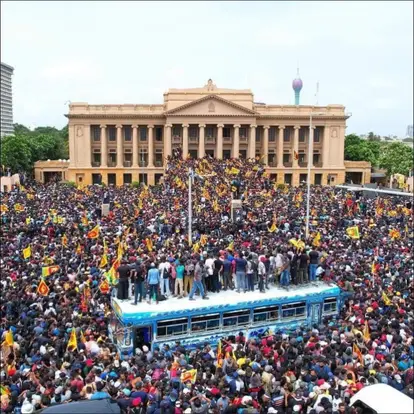On Saturday, Sri Lanka appears to have experienced a People’s Revolution. In scenes that had the hallmark of a 21st century Revolution, ordinary Sri Lankans stormed the presidential palace, forcing the unpopular President Gotabaya Rajapaksa to unceremoniously flee his residence.
Dramatic videos appeared soon after of suitcases, apparently belonging to the ousted leaders, being loaded on to a naval warship, opening floodgates of imagination of Gotabaya’s exit and possible next port of call. It later emerged that the ousted President, a former soldier, was under military protection at army headquarters. So was his brother Mahinda Rajapaksa, a former President and Prime Minister.
Also Read: Suitcases being loaded on Sri Lanka Navy ship as President Gotabaya flees
Not so long ago—in fact in 2010—the people of Tunisia had ousted the Tunisian dictator Zine El Abidine Ben Ali, triggering a string of revolutions under the overall rubric of the so-called Arab Spring. Ben Ali who was forced to flee at night in an aircraft which did not have a landing destination logged into its computers. In the end, the Saudi Royals came to the dictator’s rescue. Ben Ali was ensconced in a Jeddah palace till his death in 2019 at the age of 83. It remains to be seen what Rajapaksa’s port of call would be.
So maligned were the two brothers and their nepotistic regime, that the exit of Gotabaya Rajapaksa, in the face of the Galle face protests, almost certainly marks the end of the Rajapaksa era.
The exit of the Rajapaksas is also a big blow for China which had invested heavily in the duo, and had made massive investments ranging from roads, real estate to ports. The fury of the crowds was eminently fuelled by the Rajapaksa clan’s sell out to China, iconised by the Hambantota port. Unable to pay Chinese loans for the unviable project, the Rajapaksas in the end had to cede control of the port to the Chinese. This was an affront to Sri Lankan national sovereignty, which angry crowds gathered at Galle Face were unlikely to forget in a hurry.
Sri Lanka’s economy was also in a state of collapse. The economic meltdown has led to severe shortages of essential items including food, fuel and other necessities.
The people’s uprising is apparently good news for the United States, which has been supportive of the protests. As the crowds booted out the last remnants of the old leadership, AP reported the US ambassador to Sri Lanka , Julie Chung urged the military and police “to grant peaceful protesters the space and security to do so.”
“Chaos & force will not fix the economy or bring the political stability that Sri Lankans need right now,” Chung said in a tweet.
Another factor that indicates that Sri Lanka is undergoing a political revolution is the protesters’ demand for removal of the old-guard of the leadership, including Prime Minister Ranil Wickremasinghe. In view of the sweeping protests, the incumbent Premier has agreed to resign on Saturday after party leaders in Parliament demanded both he and the embattled president should step down.
In fact, glimpses of what a new leadership could include when former cricket superstars Sanath Jayasuriya, Mahela Jayawardena, and the wicketkeeper captain Kumara Kumar Sangakkara openly joined to the protesters and the demands a new leadership that had broken away from the old guard.
“I always stand with the People of Sri Lanka. And will celebrate victory soon. This should be continued without any violation, “ tweeted Jayasuriya.
Ialways stand with the People of Sri Lanka. And will celebrate victory soon. This should be continue without any violation. #Gohomegota#අරගලයටජය pic.twitter.com/q7AtqLObyn
— Sanath Jayasuriya (@Sanath07) July 9, 2022
But like many in the past, revolutions riding on spontaneity and romanticism ultimately led to unforeseen, if not tragic situations. Egypt, the torchbearer of the Arab Spring, got rid of the dictator Hosni Mubarak after seething protests at Tahrir Square in 2011. But after a brief flirtation with democracy, it culminated in the return of the army, which has since ruled the pivotal state. The overthrow of Muammar Gaddafi in Libya after what appeared to be a people’s revolution ultimately yielded an oil-rich failed state.
In Sri Lanka, much would depend on the role which the army would play. Will it have the patience to stay in the barracks and allow a chaotic democracy to go through its phases, starting with attempts to form a national unity government, or, in the face of social turbulence succumb to the temptation of seizing power—something which has not been uncommon among two prominent South Asian neighbours—Bangladesh and Pakistan.
For India, the fluid situation may not necessarily be bad news, precisely because New Delhi, in recent months had focused on a people-centric diplomacy, started by provisioning Covid-19 vaccines and later supplemented by dispatching life-saving food and fuel to bail out ordinary citizenry from extreme distress. That evidently has yielded enormous goodwill. But too many balls are right now in the air, and too many external forces are fishing in Sri Lanka’s turbulent waters, making bold predictions about how India would fare once the chaos ends, difficult if not impossible.
Also Read: Sri Lanka President Gotabaya flees as protesters storm official residence in Colombo




















